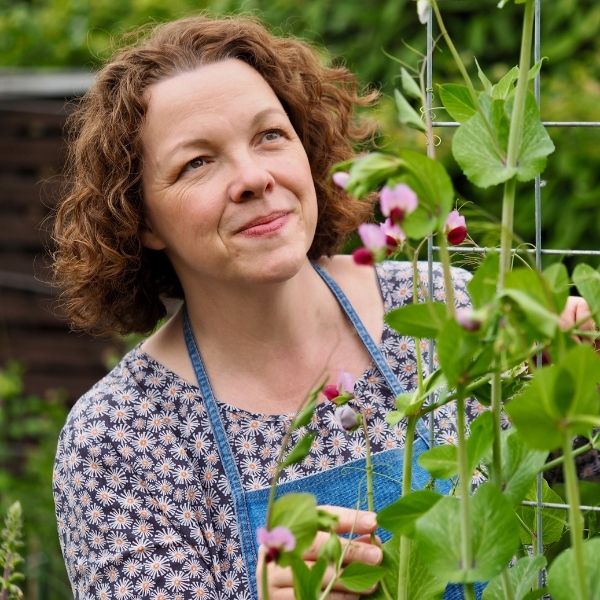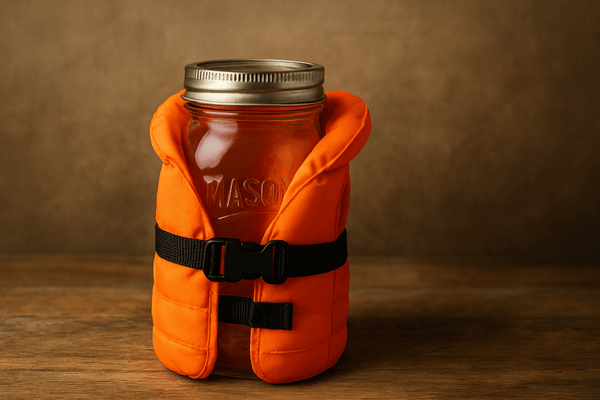The truth? No method is guaranteed. But understanding the science can help you make good decisions.
Why this post exists
Let’s get something clear right away: no home canning method – German or American, water bath or pressure – is scientifically guaranteed to be 100% safe.
That doesn’t mean it’s unsafe. It just means that scientists don’t use absolutes when talking about food safety, and instead use terms like probabilities, reductions, risks, and margins. That’s what this post is about: not which method is “safer,” but what safety actually means in the context of home canning.
This isn’t a recipe or a step-by-step guide. It’s the post I’ll refer people to when they ask, “But is it completely safe?” It’s also the foundation for every other conversation on this blog – because before we can talk about boiling times or spore loads, we have to agree on what we mean by “safe.”
Spoiler: safety in canning isn’t black and white.
What science actually means by “safe” – and how it plays out at three levels
Let’s get one thing clear: scientists don’t use the phrase “100% safe.” It sounds comforting, but it’s not a scientific concept. Instead, microbiologists use terms like risk reduction, log kill, and acceptable probability of failure. Safety, in this context, is never absolute – it’s a matter of minimizing risk to an acceptably low level.
So instead of asking “Is this safe?”, we need a better question: “How much risk does this method reduce – and is that level of risk acceptable in my kitchen?” The answer depends on the system you’re using. Here’s how that plays out across three different levels of food preservation.
Commercial sterilization (industrial canning)
Industrial food production doesn’t leave room for mistakes, because a single failure could affect thousands or millions of servings. So factories aim for commercial sterility, which uses the 12D process: a reduction in Clostridium botulinum spores by a factor of one trillion (one million times one million).
That level of kill is based on worst-case assumptions: dirty ingredients, variable processing, and no further checks once the food ships. It’s overkill by design – and necessary for unrefrigerated mass distribution. But in home kitchens? We’re not starting with a trillion spores, and we have tools to check for spoilage if something goes wrong.
Home pressure canning
Pressure canning is modeled after industrial sterilization, but scaled for home use. By increasing pressure, it raises the processing temperature to 116–121°C (240–250°F) – high enough to destroy C. botulinum spores in minutes instead of hours.
This is why the USDA recommends it for low-acid foods: it gives a huge safety margin, even if your food wasn’t perfectly clean, your jar wasn’t sealed perfectly, or your technique had flaws.
It assumes the worst and compensates with high heat. The odds of a viable spore surviving – if the method is followed exactly – are so low they’re considered negligible.
But like any system, it has limits. It depends on the right equipment, accurate timing, and the assumption that you followed the directions. Even here, the result is not sterility – just a dramatically reduced chance that anything dangerous survived the process.
German water bath canning (Einkochen)
In Germany, pressure canning never caught on. Instead, home canners have always used Einkochen – a system built around boiling water, time, and layered controls.
It doesn’t rely on one massive kill step. It spreads the work across multiple smaller ones, each reducing the risk a bit more:
- Start with clean, fresh ingredients
- Use clean jars, a clean workspace, and careful technique
- Boil the jars for a long time (often 90 to 120 minutes)
- Check every seal diligently
- Let jars sit for several weeks before eating
- Discard anything with signs of spoilage – no exceptions
- Optionally reboil before serving
This isn’t guesswork. The thermal death time data shows that even botulism spores die at 100°C – it just takes longer.
Calculating the kill rate based on these published tables shows a 4-log reduction in C. botulinum spores after 105 minutes at boiling temperature. That’s a 10,000-fold kill rate – not enough for commercial standards, but meaningful when you start with clean food and small batches.
What makes this system robust is its redundancy. If one layer misses something, another layer can catch it. You check seals. You wait. You always discard any jar that looks or smells off. And if you reboil the contents before eating, you will certainly destroy any toxin that was potentially present.
In over a century of use, this method has proven itself.
“In WECK’s more than 120-year history, we are not aware of a single case of botulism associated with canning according to the WECK method.” [translated from German]
– Das Original Einkochbuch, 2025
So no, it’s not sterile. But it’s a system – a thoughtful, time-tested, and self-correcting one.
Find out more in Seven layers of safety: why the German canning method works.
Comparing the two approaches
Both the American pressure canning method and the German water bath method aim to make food safe, but they go about it differently.
Here’s a side-by-side look at the core elements:
| Aspect | German Water Bath (Einkochen) | Pressure Canning (USDA Model) |
| Temperature | 100°C (212°F) | 116–121°C (240–250°F) |
| Primary Safety Step | Long boiling time | High heat under pressure |
| Spore Kill Rate | ~4-log reduction after 1 hour 45 minute boil* | 12-log reduction |
| Design Philosophy | Assumes clean, low-risk inputs | Assumes worst-case contamination |
| Post-Processing | Seals monitored over 2–6 weeks | Sealed jars stored immediately |
| Spoilage Protocol | Signs of spoilage = discard | Signs of spoilage = discard |
| Toxin Safeguard | Optionally reboil before eating | Prevent spore survival entirely |
| Validation | Supported by 120+ years of practical application | Scientifically tested and standardized |
* Check out The boiling point myth – why you don’t need a pressure canner to kill Clostridium botulinum spores for more details on this calculation.
Neither system is “perfect,” and neither eliminates all risk. But each uses a different balance of microbiological control, cultural practice, and user responsibility to reduce that risk to a level that feels manageable.
Why “100% safe” is a problematic phrase
Many people want guarantees when it comes to food safety – especially when the risk involves something as serious as botulism. But the phrase “100% safe” can do more harm than good.
First, it sets the wrong expectation. No microbiologist, public health agency, or canning expert can promise absolute sterility from any home preservation method. Not even pressure canning. There’s always a tiny, theoretical risk – whether from human error, equipment failure, or something as small as a stubborn spore.
Second, it oversimplifies the science. Safety isn’t binary. It’s not “safe” or “unsafe”. It’s a spectrum of risk reduction. Methods like pressure canning reduce that risk dramatically. So does long-boil water bath canning, when done carefully. But calling either “100% safe” flattens all that nuance.
And finally, it can shut down conversation. If one method is framed as the only truly safe option, it leaves no space to explore other systems – even ones with solid scientific reasoning and long-standing cultural practice behind them.
For me, “safe enough” is a more honest and more useful goal.
How I define “safe enough” in my kitchen
When I preserve food, I’m not aiming for industrial sterilization. I’m aiming for something much more practical: food that I feel confident serving to my family.
For me, “safe enough” means I’ve followed every step of the method I trust – the German water bath system – with intention and care. I use clean ingredients. I peel root vegetables. I boil for two hours when needed. I check my seals. I discard anything questionable. Usually, I reheat food before serving, just to be sure.
None of these steps on their own is perfect. But together, they form a system that makes sense to me – scientifically, historically, and personally.
It’s not about cutting corners. It’s about understanding how risk works and how it can be reduced through good technique and thoughtful observation. It’s knowing that I followed the instructions, and I understand why each of those instructions matters to the process.
This is what “safe enough” looks like in my kitchen. It might not be everyone’s definition, but it’s a definition I can stand behind.

Julie is a biologist turned science writer living in Germany. She shares her passion for traditional German water bath canning, seasonal cooking, and gardening on Old World Preserves.

